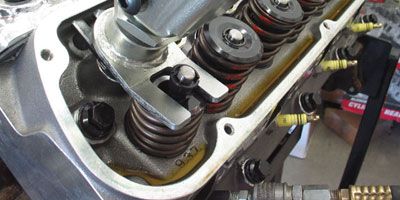
'Everybody wants to talk about bottom-of-the-page camshafts with calendar-length duration figures and valve lifts approaching 31/44 inch. With all this thinly veiled aggression going on in the valvetrain, the one overlooked component is often the valvesprings. The combination of lift, duration, and rocker ratio dictates the amount of time the valve stays open to improve flow and make more horsepower. But if the valve doesn't follow the exact path the cam lobe prescribes because the valvesprings are too weak, then the chances of making good power are greatly reduced. Engine rpm is the easy path to more horsepower, but only if the valves actually follow the dictates of the cam lobe.
While matching valvesprings to the rest of the valvetrain is a complex story that we'll save for a later date, we thought we'd attack the easy part first of how to swap valvesprings with the cylinder heads already bolted in place. This came about mainly because we discovered that our little supercharged Ford 302 that we flogged in the Dec. '07 issue ("Make 600 hp on Pump Gas") floated the valves badly at 6,300 rpm. Since the power was still climbing at 6,200, we really don't know what the true peak horsepower number is, because the valves floated before we got there. Plus, even if the engine's actual peak horsepower rpm is 6,200, best acceleration is achieved when you shift an engine roughly 300 to 400 rpm past peak horsepower. So clearly we had to address this problem.
Changing valvesprings on the engine is not difficult if you have the right tools. The trick is holding the valves in place while you remove the springs. Com-pressed air is the best way to do that, so that's how we approached this story. But let's say you're stranded on the side of the road with a broken valvespring and you don't have access to compressed air. An old-timer's trick is to feed a length of clean, nylon rope into the spark-plug hole and gently compress the rope with the piston by turning the engine over by hand until it stops turning. This should secure the valves in place while you remove the springs.
The other key to a successful valve-spring R&R party is to use the right spring-compressor tool. We've found that those lever arms are acceptable if you are dealing with stock, low-pressure springs. But for dual springs or any spring with a seat pressure of over 100 pounds, we prefer the Moroso stud-mount tool, which uses a leverage action that can take on those big dual and triple springs without a problem. We went through the drill of changing over the existing Comp Cams dual springs on our junkyard 302 with its new aluminum RHS heads and upgraded to slightly bigger springs and a set of titanium retainers to reduce the overall weight. The combination of the slightly stiffer springs with the lighter retainers should give us that extra 200 to 300 rpm we need. If nothing else, the valvetrain will be happier and live longer, too.
PARTS LIST DESCRIPTION PN SOURCE PRICE Moroso spring compressor 62370 {{{Summit}}} Racing $79.95 Moroso spark plug adapter 62385 Summit Racing 26.95 Proform spark plug adapters 67400 Summit Racing 13.39 Powerhouse height mic 101200 Powerhouse {{{62}}}.95 Comp, titanium retainer 732-16 Summit Racing 299.95Rocker Tracks
In the old Western movies, there was always an Indian who could track anything over impossible terrain. A good engine builder can also use near-invisible signs to help track the health of an engine. As we were swapping springs on our small-block Ford, we noticed an unusual wear pattern on a couple of valves. If you look closely at the accompanying photo, the valve on the right shows a typical wear pattern across the middle of the valve stem. This indicates a good pushrod length. But studying the valve-stem tip on the left, there is only a partial pattern on roughly half the width of the valve. This indicates that the valve-stem tip is not perpendicular to the stem. That places side load on the valve that can cause premature valve-guide wear. The solution for this would be to remove the head and face all the valves in a valve-grinding machine to ensure that all the valves will allow full-face contact with the rocker-arm roller tips.